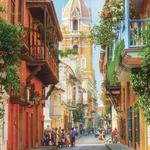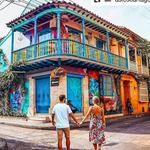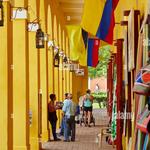Lorena & Stephen

Things To Do

COLONIAL CARTAGENA
Founded in the 16th century, Cartagena is the quintessential Caribbean paradise, lined with miles of picturesque beaches, stunning resorts, and electrifying nightclubs. Its perfectly preserved old town abounds with cobblestone streets, breathtaking churches, and flower-covered balconies. Its gorgeous setting, warm locals, and countless bars and restaurants make this colonial gem is a perfect vacation destination! We have some recommendations to ensure you experience the best of Cartagena and suggest staying within the Old Town/ Walled City so everything can be within walking distance.

CASTILLO DE SAN FELIPE DE BARAJAS
You cannot visit Cartagena without making a trip up to this huge castle, which peers out over the city. This grand construction was started in 1639 but was not completed until 150 years later. However, since its completion, it has been the crowning landmark in the city, and visitors can now stroll through the battlements, weave their way through underground passages and admire the impressive architecture.

NEIGHBORHOODS TO CHECK OUT
The Walled City: True to its name, the Walled City is not only beautiful and full of history but also extremely safe and welcoming. Bocagrande: Reminiscent of Miami’s South Beach, Bocagrande is Cartagena’s beachside strip. Perhaps one of the more traveler-inundated areas, Bocagrande is charming and safe nonetheless. Getsemani: Getsemani is Cartagena’s hipster heaven. Known for offering a uniquely Colombian feel, the neighborhood boasts street art, a wealth of coffee shops, and the always-popping tunes of Afro-Caribbean music.

BEACHES
The beaches in Cartagena are unfortunately pretty mediocre. However, there are several nearby islands and distant beaches that surround the Caribbean Peninsula; Playa Blanca in Baru, Rosario Islands, Bocagrande Beach, and Punta Arena in Tierra Bomba.

LAS BÓVEDAS
BETWEEN THE SANTA CATALINA BASTION AND THE FORMER SANTA CLARA CONVENT, CARTAGENA COLOMBIA Las Bovedas, or 'the vaults', is our favorite place to buy typical handicrafts near San Diego Plaza. Built in the late 18th century, these 23 dungeons were used as storerooms of military provisions and later as a prison. Today, they house little shops where artisans sell their crafts.